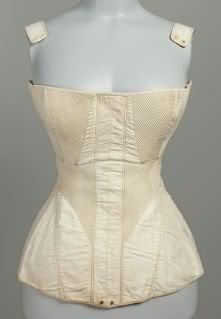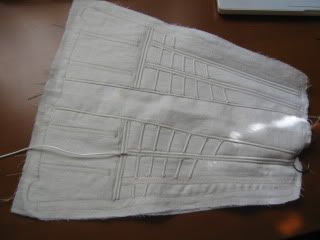Lost In Austen - Cording
There are a lot of Regency events in the Bay Area, and I felt it was high time I made myself something to wear to them. I started in on making regency stays quite a while ago, but it's only been recently (Last two months or so) that My final mock-up got fit, and everything Fell into place after getting some sound advice over in the Corsetmakers community:(http://community.livejournal.com/corsetmakers/1764673.html)
The Pattern is from Period Costumes for Stage and Screen 1800-1909 by Jean Hunnisett. It is made from one Layer cotton (lining) one layer linen (Inner layer) and one layer Satin coutil as the fashion fabric. My first two mock-ups were made from duck, and the final (See the link above) from HEAVY artists canvas. Hunnisett's pattern uses plastic boning, I decided to replace this will a decorative cording pattern on the front, back, and gores of the stays. The finished stays will have a wooden busk, and some zip tie reinforcement if needed.
Some Eye Candy:

From: http://www.mfa.org/collections/search_art.asp?recview=true&id=74890&coll_keywords=&coll_accession=&coll_name=&coll_artist=&coll_place=&coll_medium=&coll_culture=&coll_classification=Costumes&coll_credit=&coll_provenance=&coll_location=&coll_has_images=1&co
My completed and mapped out pattern:

This picture also has my samples I did. I looked at a few surviving examples of stays for cording patterns, but for the most part I simply "filled in" the bonging pattern provided by Hunnisett.
Marking the layers:

Using a soft lead pencil I transferred the markings to the linen layer. This was then basted to the coutil layer, and the channels stitched.
Inserting the cord:


I used two different methods for inserting the cord. For the smaller sections I fallowed the tutorial in Couture Sewing Techniques by Clair B. Schaffer, page 207-208. Which uses a large slightly curved needle. For the longer sections I used a bodkin, which was slightly problematic, but still got the job done. In both cases I found it easier to insert the cord through the linen at the sections beginning and end, rather than between the two fabrics at the edges.
After cording:
Linen Side:

Coutil Side:

I left myself very large borders on my pieces. This made the pieces easier to handle, but also allowed for shrinkage adjustment (as discussed in the corsetmakers post). Over all the bust gores shrank 1/8inch lengthwise, and the hip gores 1/4 inch. The front, back, or side panels did not shrink discernibly.
The 99% finished cording:

All of visible thread on the face side is shiny embroidery thread in cream, the thread on the inside is plain stitching thread. I say 99% because I am waiting to cord one section of the side panels until after I put the hip gores in. They are just so close together, it will be easier to do it after.
My lining is all cut out, now I just need to find some time to start stitching...which will probably be a week from now at the soonest :(
And in other news: In the new version of Robin Hood, Cate Blanchett ("Maid" Marrian) appears to be wearing some sort of corded bodice/corset under her medieval gown: http://www.flickr.com/photos/48671811@N07/4458956306/
The Pattern is from Period Costumes for Stage and Screen 1800-1909 by Jean Hunnisett. It is made from one Layer cotton (lining) one layer linen (Inner layer) and one layer Satin coutil as the fashion fabric. My first two mock-ups were made from duck, and the final (See the link above) from HEAVY artists canvas. Hunnisett's pattern uses plastic boning, I decided to replace this will a decorative cording pattern on the front, back, and gores of the stays. The finished stays will have a wooden busk, and some zip tie reinforcement if needed.
Some Eye Candy:

From: http://www.mfa.org/collections/search_art.asp?recview=true&id=74890&coll_keywords=&coll_accession=&coll_name=&coll_artist=&coll_place=&coll_medium=&coll_culture=&coll_classification=Costumes&coll_credit=&coll_provenance=&coll_location=&coll_has_images=1&co
My completed and mapped out pattern:

This picture also has my samples I did. I looked at a few surviving examples of stays for cording patterns, but for the most part I simply "filled in" the bonging pattern provided by Hunnisett.
Marking the layers:

Using a soft lead pencil I transferred the markings to the linen layer. This was then basted to the coutil layer, and the channels stitched.
Inserting the cord:


I used two different methods for inserting the cord. For the smaller sections I fallowed the tutorial in Couture Sewing Techniques by Clair B. Schaffer, page 207-208. Which uses a large slightly curved needle. For the longer sections I used a bodkin, which was slightly problematic, but still got the job done. In both cases I found it easier to insert the cord through the linen at the sections beginning and end, rather than between the two fabrics at the edges.
After cording:
Linen Side:

Coutil Side:

I left myself very large borders on my pieces. This made the pieces easier to handle, but also allowed for shrinkage adjustment (as discussed in the corsetmakers post). Over all the bust gores shrank 1/8inch lengthwise, and the hip gores 1/4 inch. The front, back, or side panels did not shrink discernibly.
The 99% finished cording:

All of visible thread on the face side is shiny embroidery thread in cream, the thread on the inside is plain stitching thread. I say 99% because I am waiting to cord one section of the side panels until after I put the hip gores in. They are just so close together, it will be easier to do it after.
My lining is all cut out, now I just need to find some time to start stitching...which will probably be a week from now at the soonest :(
And in other news: In the new version of Robin Hood, Cate Blanchett ("Maid" Marrian) appears to be wearing some sort of corded bodice/corset under her medieval gown: http://www.flickr.com/photos/48671811@N07/4458956306/